Charles E W Bean, Diaries, AWM38 3DRL 606/247/1 - 1917 - 1933 - Part 17
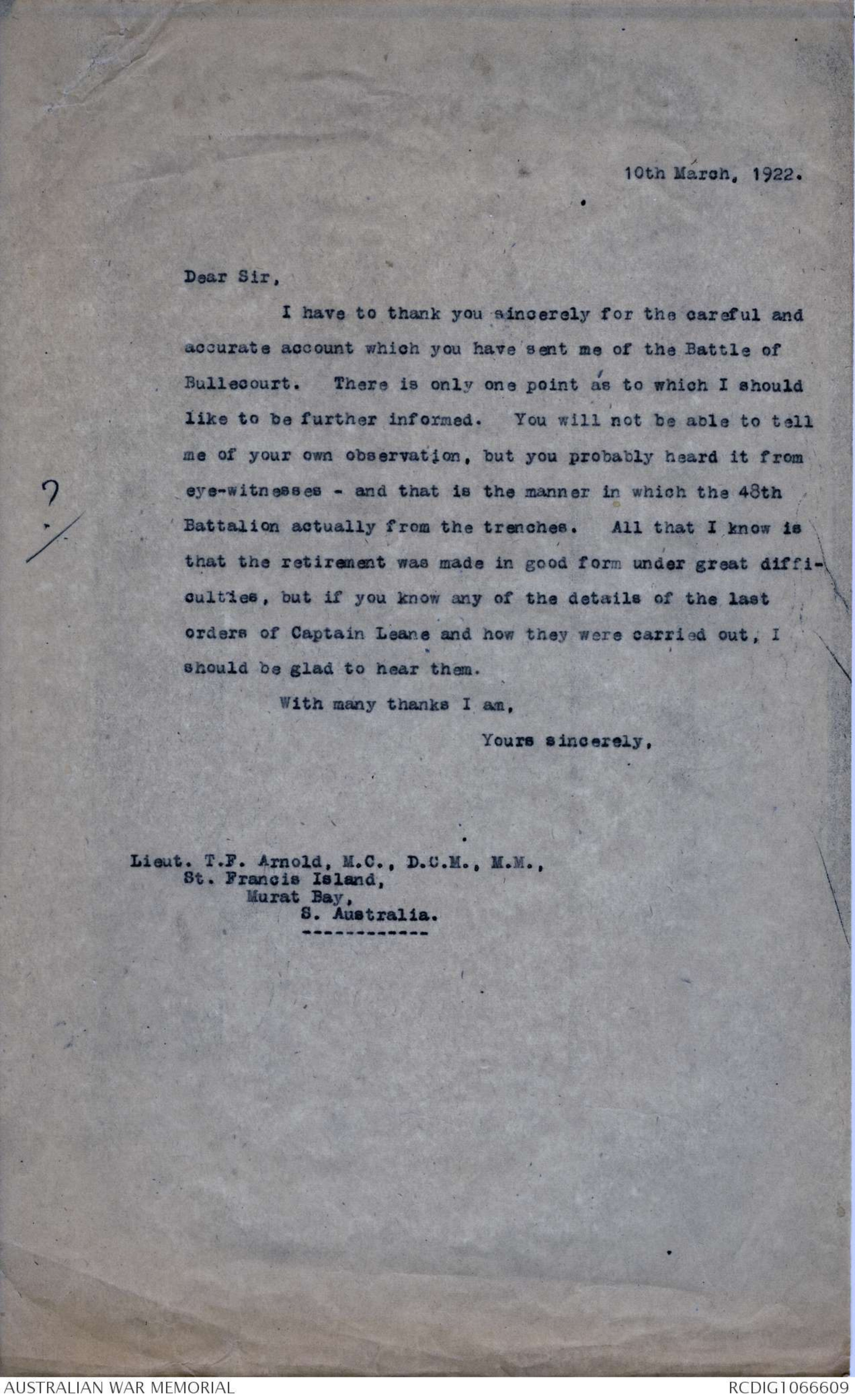
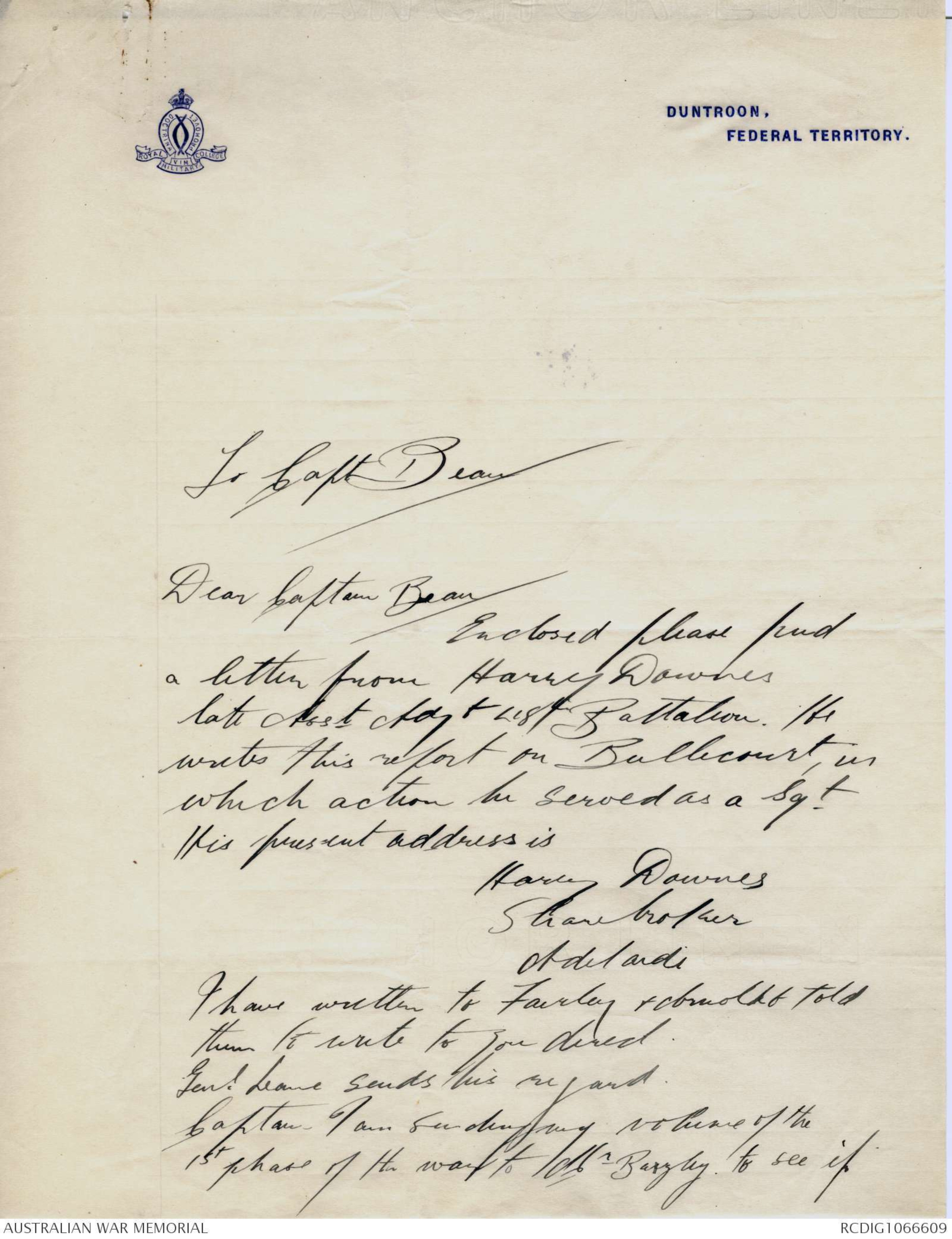
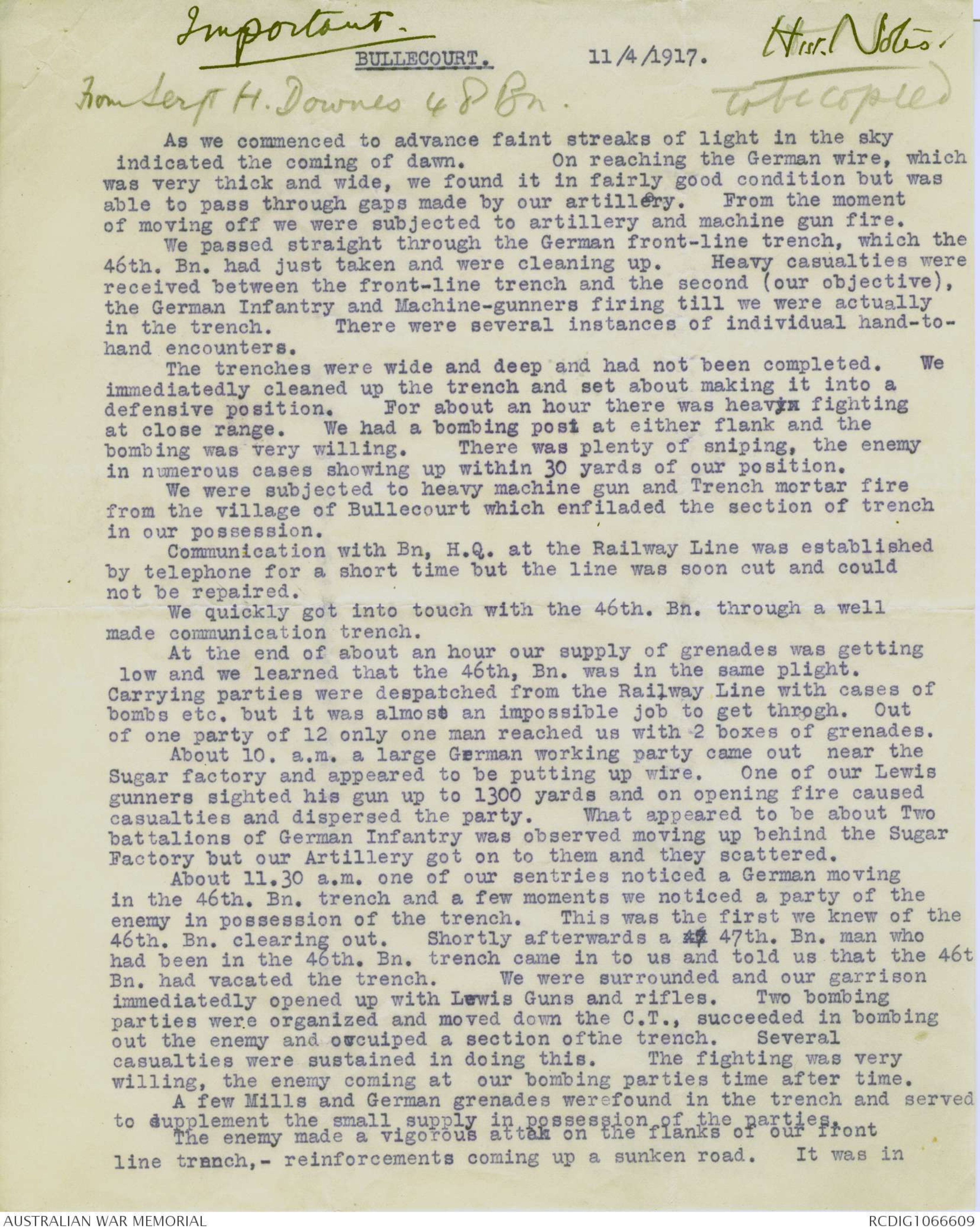
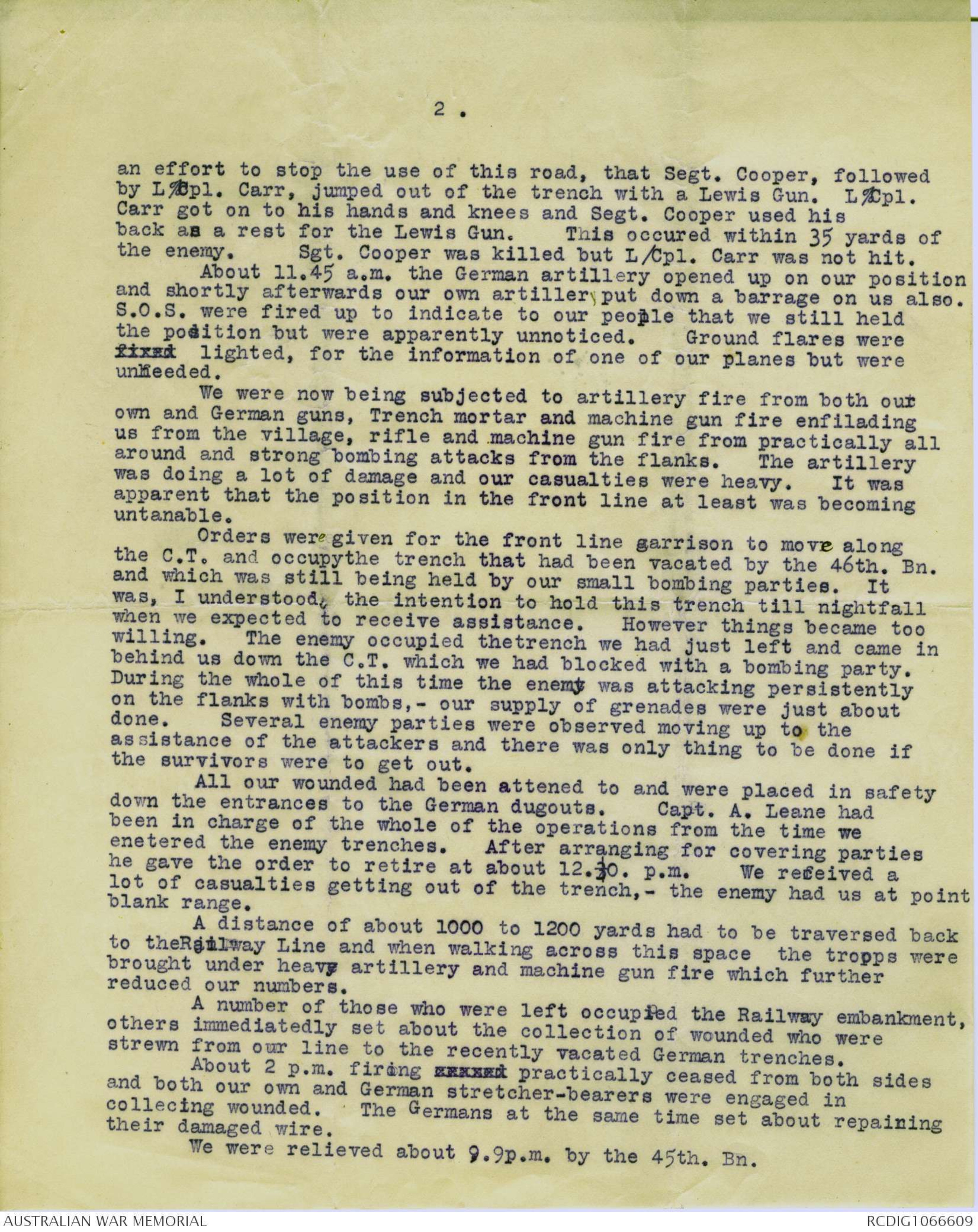
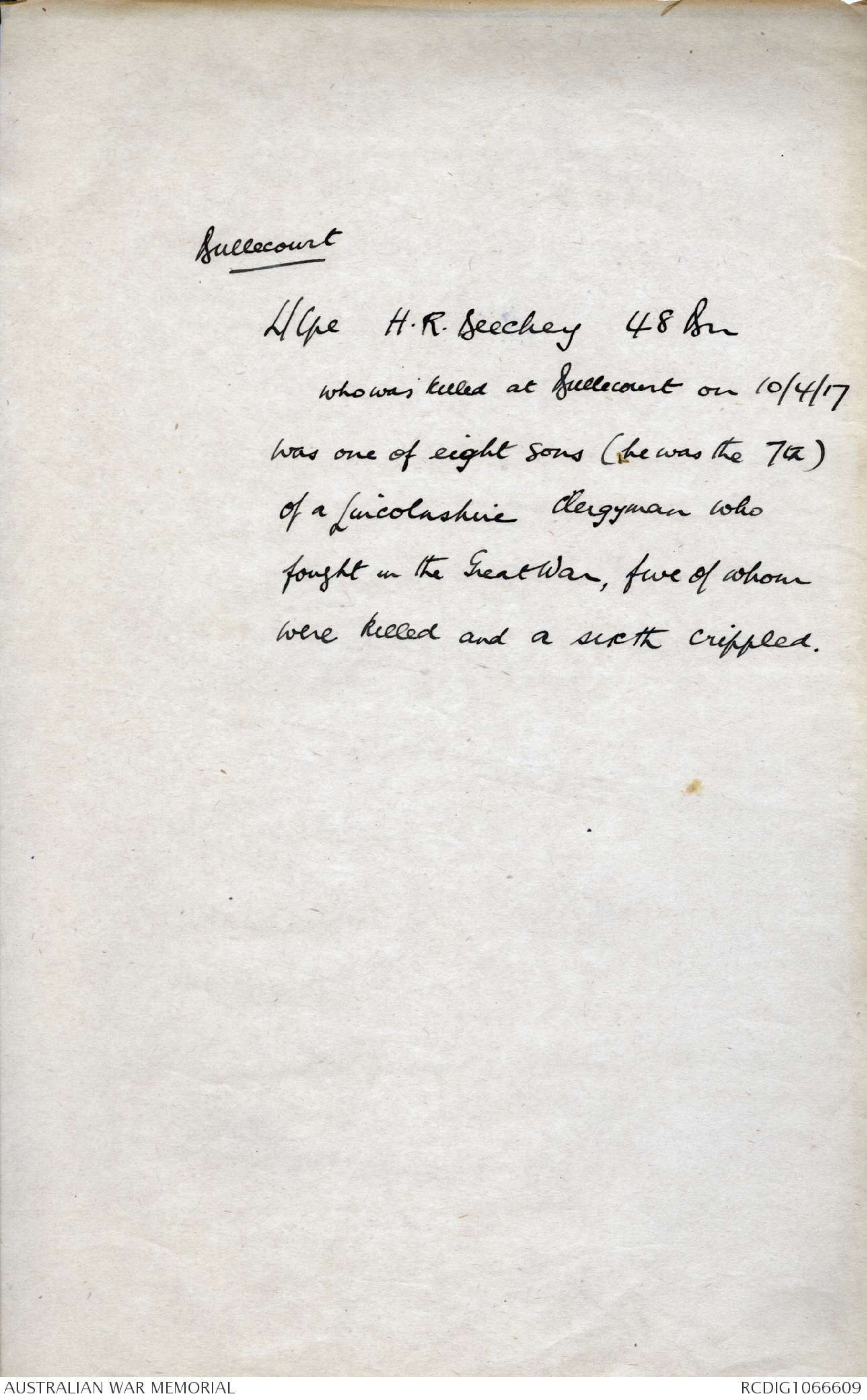
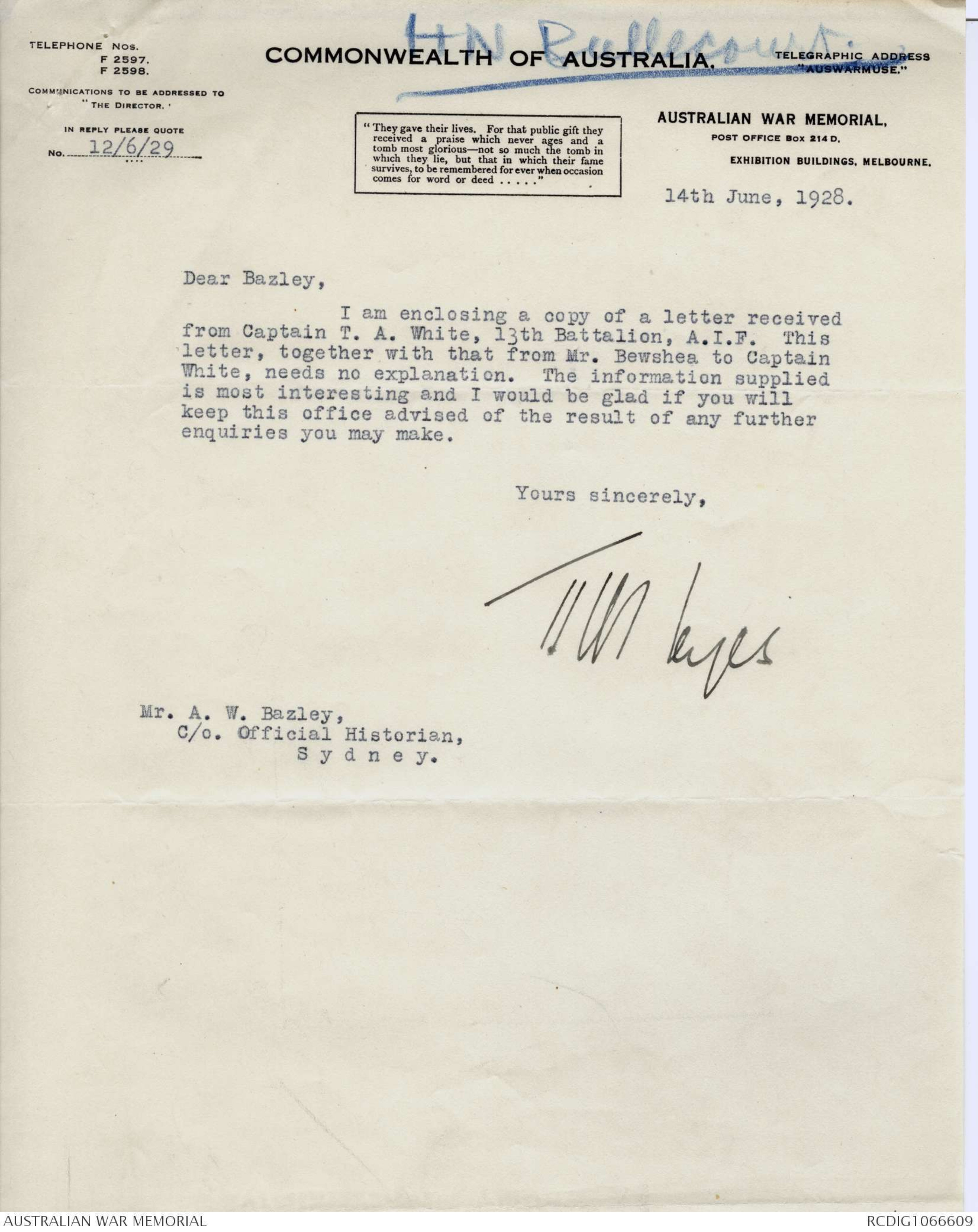
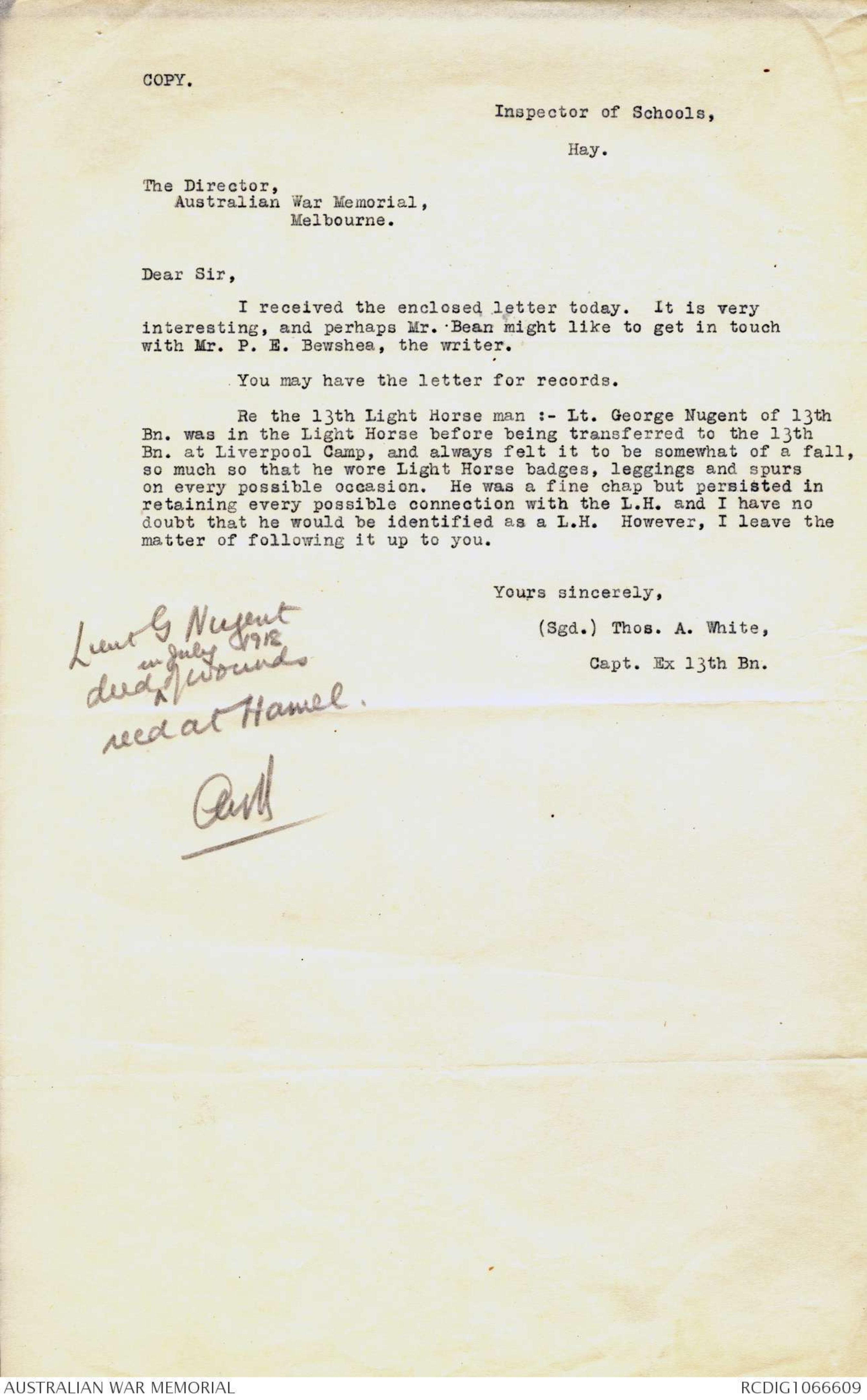
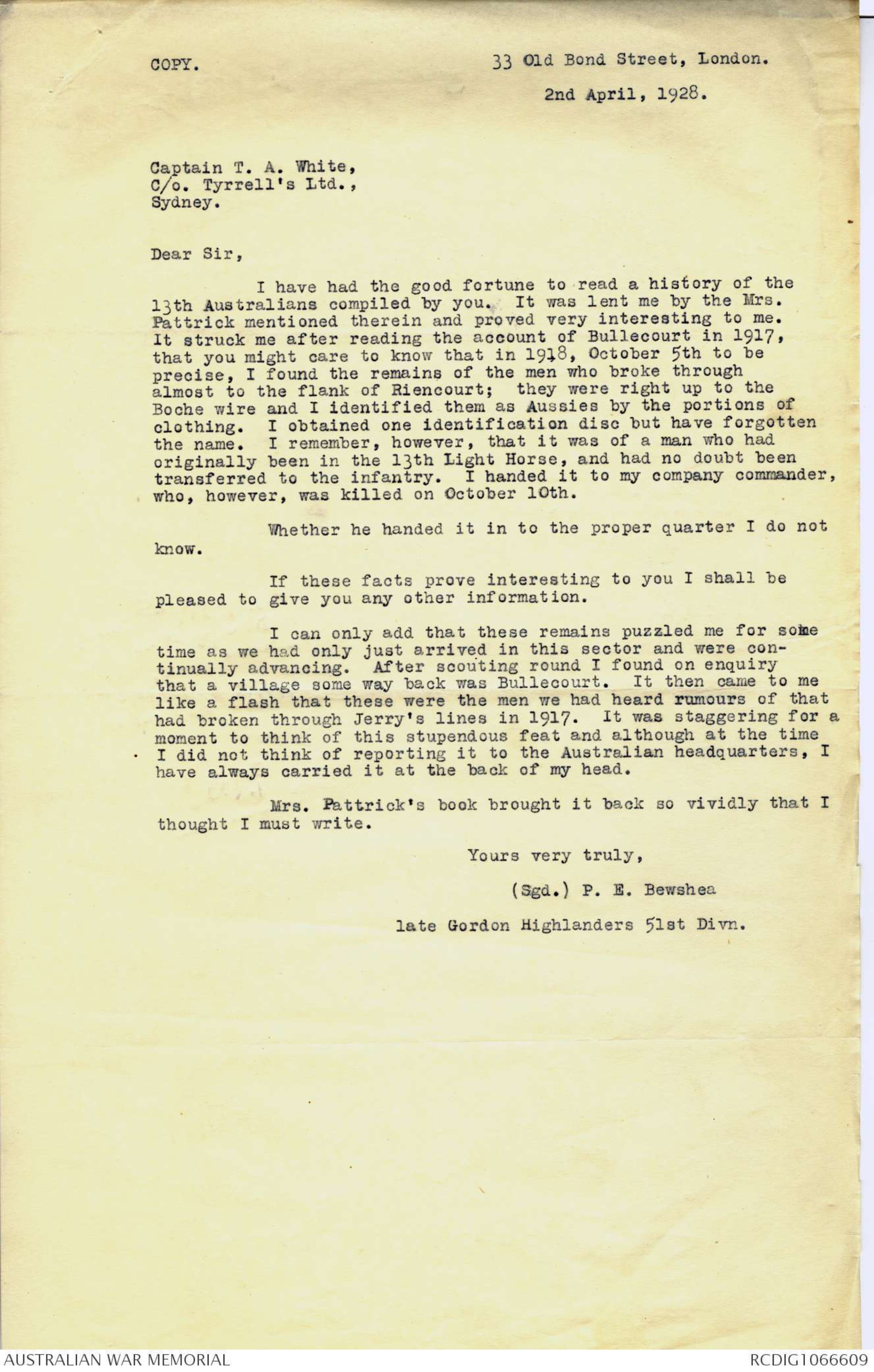
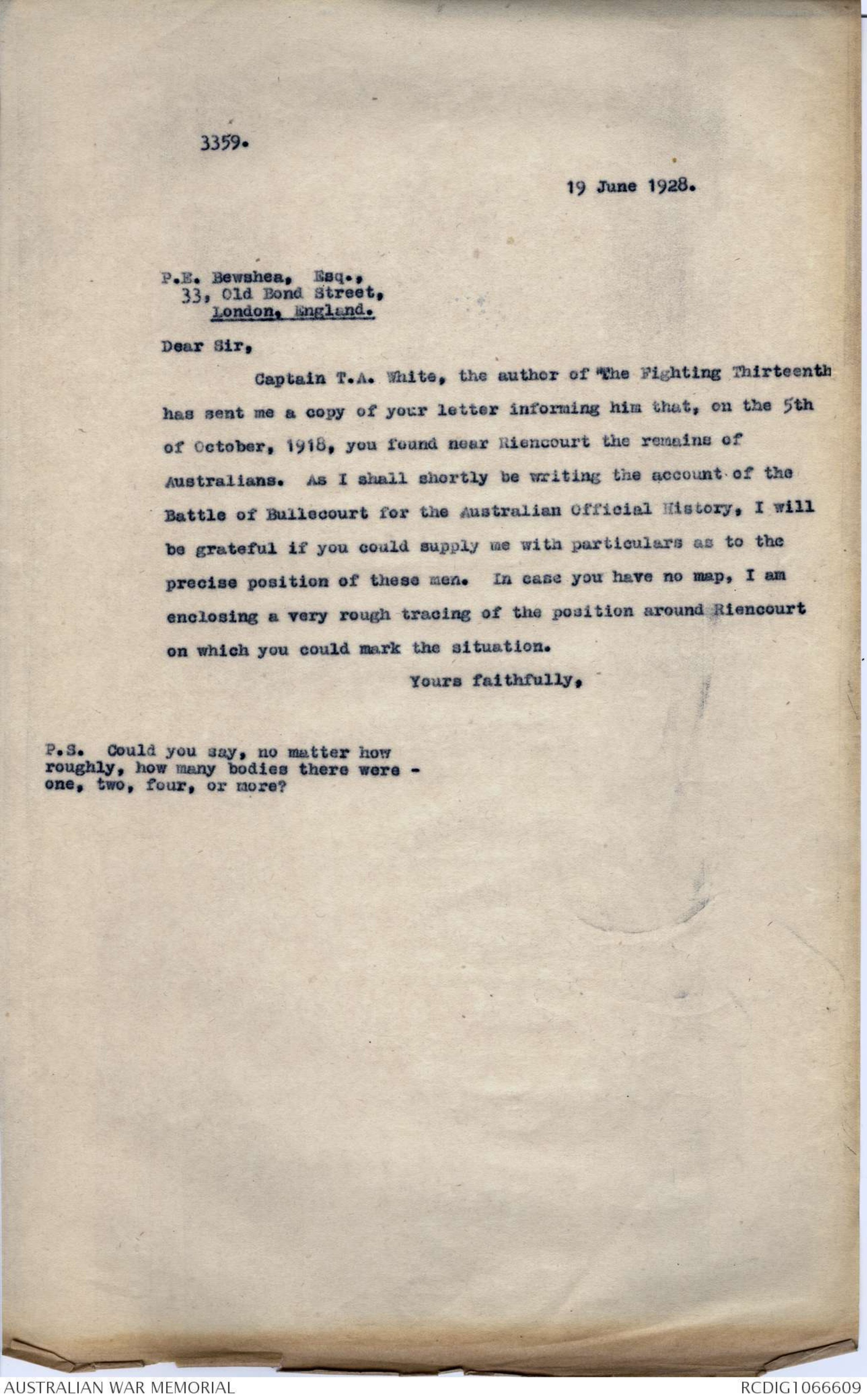
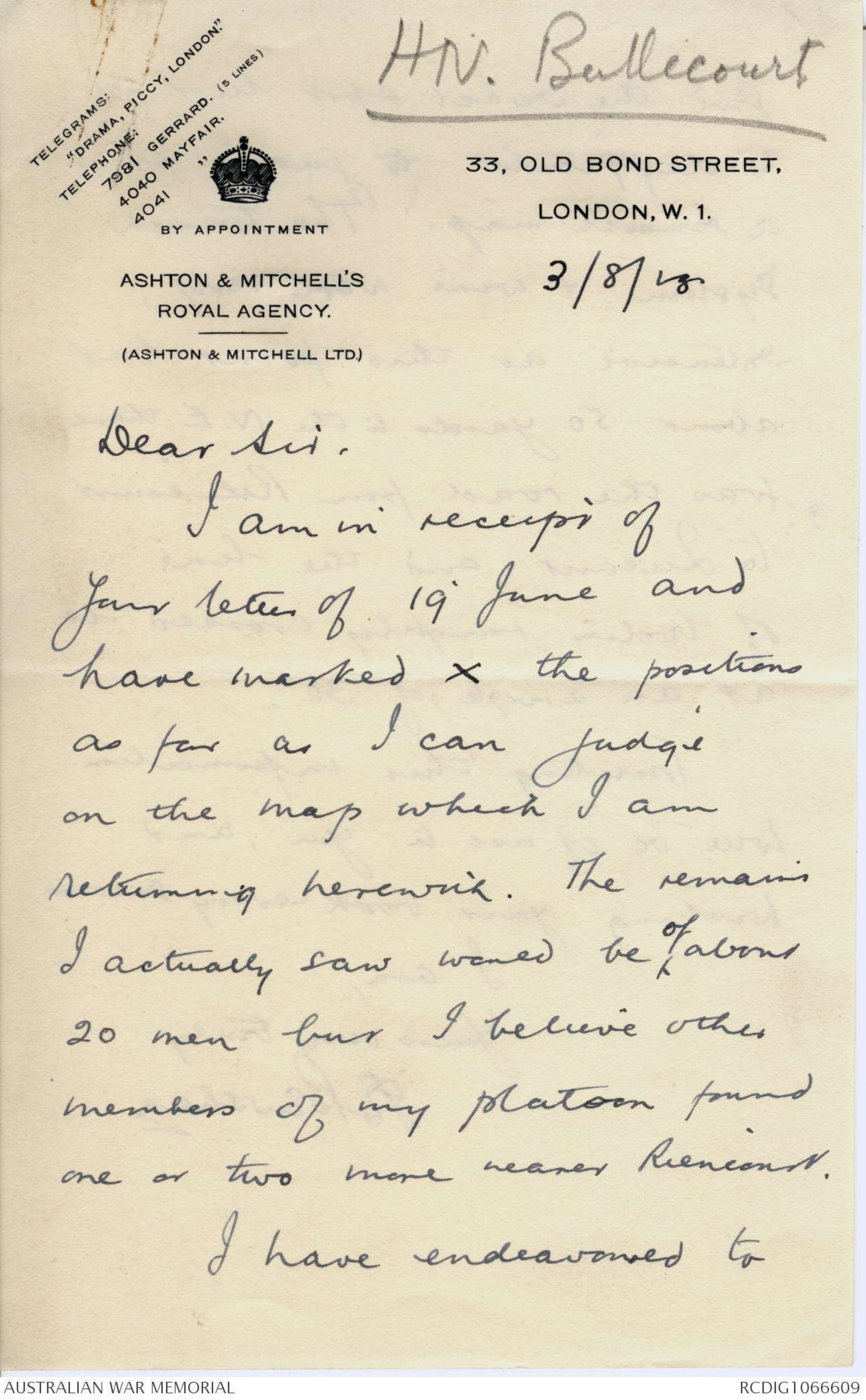
10th March, 1922.
Dear Sir,
I have to thank you sincerely for the careful and
accurate account which you have sent me of the Battle of
Bullecourt. There is only one point as to which I should
like to be further informed. You will not be able to tell
me of your own observation, but you probably heard it from
[*?*] eye-witnesses - and that is the manner in which the 48th
Battalion actually from the trenches. All that I know is
that the retirement was made in good form under great difficulties,
but If you know any of the details of the last
orders of Captain Leane and how they were carried out, I
should be glad to hear them.
With many thanks I am,
Yours sincerely,
Lieut. T.F. Arnold, M.C., D.C.M., M.M.,
St. Francis Island,
Murat Bay
S. Australia
DUNTROON,
FEDERAL TERRITORY.
To Capt Bean
Dear Captain Bean
Enclosed please find
a letter from Harry Downes
late Asst Adjt 48th Battalion. He
writes this report on Bullecourt, in
which action he served as a Sgt.
His present address is
Harry Downes
Share broker
Adelaide
I have written to Fairley & Arnold told
them to write to you direct.
Genl. Leane sends his regard.
Captain I am sending my volume of the
1st phase of the war to Mr Bazley to see if
[*Important.*]
BULLECOURT.
11/4/1917
[*From Sergt H. Downes 48 Bn.*]
[*Hist. Notes.
to be copied*]
As we commenced to advance faint streaks of light in the sky
indicated the coming of dawn. On reaching the German wire, which
was very thick and wide, we found it in fairly good condition but was
able to pass through gaps made by our artillery. From the moment
of moving off we were subjected to artillery and machine gun fire.
We passed straight through the German front-line trench, which the
46th. Bn. had just taken and were cleaning up. Heavy casualties were
received between the front-line trench and the second (our objective),
the German Infantry and Machine-gunners firing till we were actually
in the trench. There were several instances of individual hand-to-hand encounters.
The trenches were wide and deep and had not been completed. We
immediately cleaned up the trench and set about making it into a
defensive position. For about an hour there was heavyn fighting
at close range. We had a bombing post at either flank and the
bombing was very willing. There was plenty of sniping, the enemy
in numerous cases showing up within 30 yards of our position.
We were subjected to heavy machine gun and Trench mortar fire
from the village of Bullecourt which enfiladed the section of trench
in our possession.
Communication with Bn, H.Q. at the Railway Line was established
by telephone for a short time but the line was soon cut and could
not be repaired.
We quickly got into touch with the 46th. Bn. through a well
made communication trench.
At the end of about an hour our supply of grenades was getting
low and we learned that the 46th, Bn. was in the same plight.
Carrying parties were despatched from the Railway Line with cases of
bombs etc. but it was almost an impossible job to get throgh. Out
of one party of 12 only one man reached us with 2 boxes of grenades.
About 10. a.m. a large German working party came out near the
Sugar factory and appeared to be putting up wire. One of our Lewis
gunners sighted his gun up to 1300 yards and on opening fire caused
casualties and dispersed the party. What appeared to be about Two battalions of German Infantry was observed moving up behind the Sugar
Factory but our Artillery got on to them and they scattered.
About 11.30 a.m. one of our sentries noticed a German moving
in the 46th. Bn. trench and a few moments we noticed a party of the
enemy in possession of the trench. This was the first we knew of the
46th. Bn. clearing out. Shortly afterwards a 46 47th. Bn. man who
had been in the 46th. Bn. trench came in to us and told us that the 46t
Bn. had vacated the trench. We were surrounded and our garrison
immediately opened up with Lewis Guns and rifles. Two bombing
parties were organized and moved down the C.T., succeeded in bombing
out the enemy and occupied a section of the trench. Several
casualties were sustained in doing this. The fighting was very
willing, the enemy coming at our bombing parties time after time.
A few Mills and German grenades were found in the trench and served
to supplement the small supply in possession, of the parties,
The enemy made a vigorous attack on the flanks of our front
line trench, - reinforcements coming up a sunken road. It was in
2.
an effort to stop the use of this road, that Segt. Cooper, followed
by L%Cpl Carr, jumped out of the trench with a Lewis Gun. L%Cpl.
Carr got on to his hands and knees and Segt. Cooper used his
back as a rest for the Lewis Gun. This occured within 35 yards of
the enemy. Sgt. Cooper was killed but L/ Cpl. Carr was not hit.
About 11.45 a.m. the German artillery opened up on our position
and shortly afterwards our own artillery put down a barrage on us also.
S.O.S. were fired up to indicate to our people that we still held
the position but were apparently unnoticed. Ground flares werefired lighted, for the information of one of our planes but were
unheeded.
We were now being subjected to artillery fire from both our
own and German guns, Trench mortar and machine gun fire enfilading
us from the village, rifle and machine gun fire from practically all
around and strong bombing attacks from the flanks. The artillery
was doing a lot of damage and our casualties were heavy. It was
apparent that the position in the front line at least was becoming
untanable.
Orders were given for the front line garrison to move along
the C.T. and occupy the trench that had been vacated by the 46th. Bn.
and which was still being held by our small bombing parties. It
was, I understood, the intention to hold this trench till nightfall
when we expected to receive assistance. However things became too
willing. The enemy occupied the trench we had just left and came in
behind us down the C.T. which we had blocked with a bombing party.
During the whole of this time the enemy was attacking persistently
on the flanks with bombs, - our supply of grenades were just about
done. Several enemy parties were observed moving up to the
assistance of the attackers and there was only thing to be done if
the survivors were to get out.
All our wounded had been attened to and were placed in safety
down the entrances to the German dugouts. Capt. A. Leane had
been in charge of the whole of the operations from the time we
enetered the enemy trenches. After arranging for covering parties
he gave the order to retire at about 12.30. p.m. We received a
lot of casualties getting out of the trench, - the enemy had us at point
blank range.
A distance of about 1000 to 1200 yards had to be traversed back
to the Railway Line and when walking across this space the troops were
brought under heavy artillery and machine gun fire which further
reduced our numbers.
A number of those who were left occupied the Railway embankment,
others immediatedly set about the collection of wounded who were
strewn from our line to the recently vacated German trenches.
About 2 p.m. firing ceased practically ceased from both sides
and both our own and German stretcher-bearers were engaged in
collecing wounded. The Germans at the same time set about repairing
their damaged wire.
We were relieved about 9.9p.m. by the 45th. Bn.
Bullecourt
L/Cpl H. R. Beechey 48 Bn
who was killed at Bullecourt on 10/4/17
was one of eight sons (he was the 7th)
of a Lincolnshire clergyman who
fought in the Great War, five of whom
were killed and a sixth crippled.
COMMONWEALTH OF AUSTRALIA
[*H N Bullecourt.*]
TELEGRAPHIC ADDRESS
"AUSWARMUSE"
AUSTRALIAN WAR MEMORIAL,
POST OFFICE Box 214 D,
EXHIBITION BUILDINGS, MELBOURNE.
TELEPHONE Nos.
F 2597.
F 2598.
COMMUNICATIONS TO BE ADDRESSED TO
"THE DIRECTOR."
IN REPLY PLEASE QUOTE
No. 12/6/29
"They give their lives. For that public gift they
received a praise which never ages and a
tomb most glorious—not so much the tomb in
which they lie, but that in which their fame
survives, to be remembered for ever when occasion
comes for word or deed. . . . . "
14th June, 1928.
Dear Bazley,
I am enclosing a copy of a letter received
from Captain T. A. White, 13th Battalion, A.I.F. This
letter, together with that from Mr. Bewshea to Captain
White, needs no explanation. The information supplied
is most interesting and I would be glad if you will
keep this office advised of the result of any further
enquiries you may make.
Yours sincerely,
[[?]]
Mr. A. W. Bazley
C/o. Official Historian,
S y d n e y.
COPY.
Inspector of Schools,
Hay.
The Director,
Australian War Memorial,
Melbourne.
Dear Sir,
I received the enclosed letter today. It is very
interesting, and perhaps Mr. Bean might like to get in touch
with Mr. P. E. Bewshea, the writer.
You may have the letter for records.
Re the 13th Light Horse man :- Lt. George Nugent of 13th
Bn. was in the Light Horse before being transferred to the 13th
Bn. at Liverpool Camp, and always felt it to be somewhat of a fall,
so much so that he wore Light Horse badges, leggings and spurs
on every possible occasion. He was a fine chap but persisted in
retaining every possible connection with the L.H. and I have no
doubt that he would be identified as a L.H. However, I leave the
matter of following it up to you.
Yours sincerely,
(Sgd.) Thos. A. White,
Capt. Ex 13th Bn.
[*Lieut G Nugent
died ^in July 1918 of wounds
recd at Hamel.
[[?]]*]
COPY.
33 Old Bond Street, London.
2nd April, 1928.
Captain T. A. White,
C/o. Tyrrell's Ltd.,
Sydney.
Dear Sir,
I have had the good fortune to read a history of the
13th Australians compiled by you. It was lent me by the Mrs.
Pattrick mentioned therein and proved very interesting to me.
It struck me after reading the account of Bullecourt in 1917,
that you might care to know that in 1918, October 5th to be
precise, I found the remains of the men who broke through
almost to the flank of Riencourt; they were right up to the
Boche wire and I identified them as Aussies by the portions of
clothing. I obtained one identification disc but have forgotten
the name. I remember, however, that it was of a man who had
originally been in the 13th Light Horse, and had no doubt been
transferred to the infantry. I handed it to my company commander,
who, however, was killed on October 10th.
Whether he handed it in to the proper quarter I do not
know.
If these facts prove interesting to you I shall be
pleased to give you any other information.
I can only add that these remains puzzled me for some
time as we had only just arrived in this sector and were continually
advancing. After scouting round I found on enquiry
that a village some way back was Bullecourt. It then came to me
like a flash that these were the men we had heard rumours of that
had broken through Jerry's lines in 1917. It was staggering for a
moment to think of this stupendous feat and although at the time
I did not think of reporting it to the Australian headquarters, I
have always carried it at the back of my head.
Mrs. Pattrick's book brought it back so vividly that I
thought I must write.
Yours very truly,
(Sgd.) P. E. Bewshea
late Gordon Highlanders 51st Divn.
3359.
19 June 1928.
P.E. Bewshea, Esq.,
33, Old Bond Street,
London, England.
Dear Sir,
Captain T.A. White, the author of the Fighting Thirteenth
has sent me a copy of your letter informing him that, on the 5th
of October, 1918, you found near Riencourt the remains of
Australians. As I shall shortly be writing the account of the
Battle of Bullecourt for the Australian Official History, I will
be grateful if you could supply me with particulars as to the
precise position of these men. In case you have no map, I am
enclosing a very rough tracing of the position around Riencourt
on which you could mark the situation.
Yours faithfully,
P.S. Could you say, no matter how
roughly, how many bodies there were -
one, two, four, or more?
[*H N. Bullecourt*]
TELEGRAMS:
"DRAMA, PICCY, LONDON."
TELEPHONE:
7981 GERRARD. (5 Lines)
4040 MAYFAIR.
4041 "
BY APPOINTMENT
ASHTON & MITCHELL'S
ROYAL AGENCY.
(ASHTON & MITCHELL LTD.)
33, OLD BOND STREET,
LONDON, W. 1.
3/8/28
Dear Sir.
I am in receipt of
your letter of 19' June and
have marked x the positions
as far as I can judge
on the map which I am
returning herewith. The remains
I actually saw would be ^of about
20 men but I believe other
members of my platoon found
one or two more nearer Riencourt.
I have endeavoured to
 Deb Parkinson
Deb ParkinsonThis transcription item is now locked to you for editing. To release the lock either Save your changes or Cancel.
This lock will be automatically released after 60 minutes of inactivity.